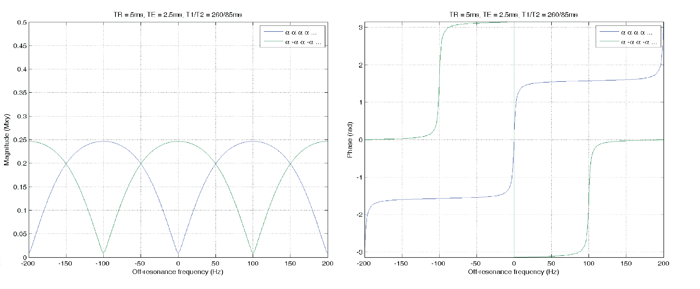Variation of excitation pulse train
3. Variation of excitation pulse train
In this part, we show some examples of the evolution of magnetization at different excitation pulse train.
3.1 a, a, a, a, vs a, -a, a, -a,
The movies show that the dynamics of the magnetization for the two cases are different. The signal-off-resonance characteristics (both magnitude and phase of the signal) depend on the excitation pulse train. Note that the curves for a, -a, a, -a, are shifted by 1/(2TR) in the off-resonance frequency axis from the curves of a, a, a, a, . All simulated parameters are the same as in 1.1.

3.2 a, -a, a, -a, vs a/2, -a, a, -a, a,
The results show the influence of an a/2 preparation pulse which is applied only once at the beginning. The magnetization approaches to the steady state smoothly in the presence of a/2 preparation pulse. Without the preparation pulse, the pulse train produces signal fluctuations which can cause severe image artifacts. The simulations were done using the following parameters: T1 = 200 ms, T2 = 50 ms, TR = 10 ms, TE = TR/2, flip angle a = 60° and only on-resonance frequency.
References
[1] Carr HY. Steady-state free precession in nuclear magnetic resonance. Phys. Rev. (1958) 112:1693-1701.
[2] Scheffler K and Lehnhardt S. Principles and applications of balanced SSFP techniques. Eur. Radiol. (2003) 13:2409-2418.
| By Myung-Ho In / Chaiya Luengviriya |






